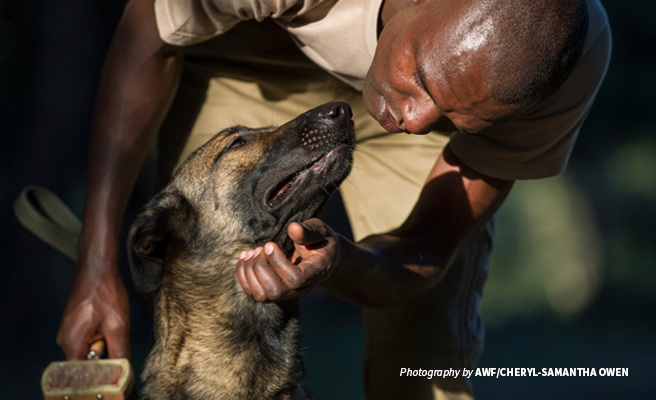Conservation sniffer dogs: How a unique human-canine bond leads to wildlife detection

When resources are available, advanced technologies such as drone surveillance or other tracking and sensing systems might be the fastest way to nab wildlife offenders. But anti-poaching and anti-trafficking work also relies on low-tech, tried-and-true methods. One of the oldest and most reliable? Dogs. African Wildlife Foundation leads the way in the use of detection dogs to combat the illegal wildlife trade. In partnership with wildlife authorities such as the Kenya Wildlife Service, our Canines for Conservation dog-and-handler teams — deployed at airports and other trafficking hotspots — have uncovered millions of dollars’ worth of ivory, rhino horn, and other illegal wildlife products.
To date, AWF canine detection units are based in Kenya, Uganda, and Tanzania. We are also expanding our efforts and deploying dog-and-handler teams to Mozambique, Botswana, and Cameroon.
Wildlife sniffer dogs and handlers work on mutual trust and respect
The program’s talented dogs — shepherds and Springer spaniels mostly — undergo three months of training to become expert at detecting and signaling the presence of contraband.
With their powerful senses of smell, these working dogs detect everything from full tusks to ivory jewelry and rhino horn dust — even when items are concealed in coffee or powdered milk. When the dog detects a stash, it signals his or her handler by sitting or freezing at that spot.
The dogs are only half the equation. Each one is paired with a dedicated handler — generally rangers from wildlife authorities. During training, the focus is not just on refining sniffing skills, but on the relationship.
[[{"fid":"75241","view_mode":"full","fields":{"format":"full","alignment":"","field_file_image_alt_text[und][0][value]":"Photo of AWF-trained wildlife sniffer dog unit demonstrating wildlife detection at AWF training facility","field_file_image_title_text[und][0][value]":"Wildlife detection sniffer dogs and their handlers are trained by AWF experts and deployed at exit ports","field_caption[und][0][value]":"","field_caption[und][0][format]":"full_html"},"link_text":null,"type":"media","field_deltas":{"3":{"format":"full","alignment":"","field_file_image_alt_text[und][0][value]":"Photo of AWF-trained wildlife sniffer dog unit demonstrating wildlife detection at AWF training facility","field_file_image_title_text[und][0][value]":"Wildlife detection sniffer dogs and their handlers are trained by AWF experts and deployed at exit ports","field_caption[und][0][value]":"","field_caption[und][0][format]":"full_html"}},"attributes":{"alt":"Photo of AWF-trained wildlife sniffer dog unit demonstrating wildlife detection at AWF training facility","title":"Wildlife detection sniffer dogs and their handlers are trained by AWF experts and deployed at exit ports","height":400,"width":656,"class":"media-element file-full","data-delta":"3"}}]]
Will Powell, director of the Canines program, says, “The dogs and their handlers must be totally in love with each other. The first week of their training is simply about creating the bond that cements the partnership for the training to come, involving play and just hanging out. Once this bond is established, we can start work.”
It is easy to focus on the dogs and forget about the handlers, but handlers are the ones who care for the dogs, learn to understand them, and are the leaders of these elite anti-trafficking units.
“The relationship between the dog and his or her handler is one of the most important factors in the success of any program like this,” says Powell, who for many years trained dogs to detect landmines and explosives before turning his attention to conservation. “If the dog and handler don’t trust, respect and love one another, the partnership breaks down.”
[[{"fid":"75240","view_mode":"full","fields":{"format":"full","alignment":"","field_file_image_alt_text[und][0][value]":"Close-up photo of wildlife sniffer dog trained by AWF's expert Canine Detection Unit","field_file_image_title_text[und][0][value]":"AWF's wildlife detection sniffer and tracker dogs deter potential poachers and traffickers ","field_caption[und][0][value]":"","field_caption[und][0][format]":"full_html"},"link_text":null,"type":"media","field_deltas":{"2":{"format":"full","alignment":"","field_file_image_alt_text[und][0][value]":"Close-up photo of wildlife sniffer dog trained by AWF's expert Canine Detection Unit","field_file_image_title_text[und][0][value]":"AWF's wildlife detection sniffer and tracker dogs deter potential poachers and traffickers ","field_caption[und][0][value]":"","field_caption[und][0][format]":"full_html"}},"attributes":{"alt":"Close-up photo of wildlife sniffer dog trained by AWF's expert Canine Detection Unit","title":"AWF's wildlife detection sniffer and tracker dogs deter potential poachers and traffickers ","height":400,"width":656,"class":"media-element file-full","data-delta":"2"}}]]
Tracking and detection dogs deter wildlife offenders
Well-trained dogs and skilled handlers are not only a superb means of detecting smuggled wildlife products at transportation hubs. These units also work as tracking teams that can follow the scent of poachers back to villages after an illegal kill or capture.
A successful track can leave a lasting impression among local people. “Just being seen is important,” says Powell. “Deterrence is a huge piece.”
By raising the stakes of poaching and of moving illegal wildlife products to market, the presence of both tracking dogs and sniffer dogs at exit ports make the illegal wildlife trade much less attractive to would-be perpetrators.
During dry runs, Canines for Conservation dogs get to chase Kong rubber dog toys as a reward for finding stashes. They love their Kongs, but their wagging tails and other body language suggest they love being detectives, too. Intensely focused, they scurry under and around the demonstration cars — here, there, and back again — before honing in on the planted stash. Then they either abruptly sit or plant themselves low to the ground.
It is clearly fun for them, but at the end of the day, these dedicated, big-hearted dogs show us that man’s best friend can also be one of wildlife’s most valuable friends.
> Learn how AWF’s specialized law enforcement are bolstering wildlife crime conviction rates